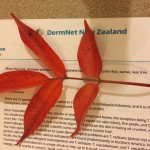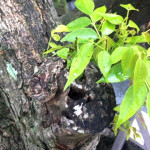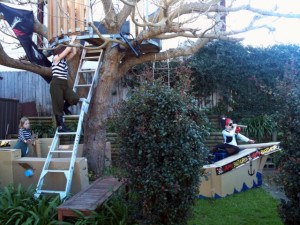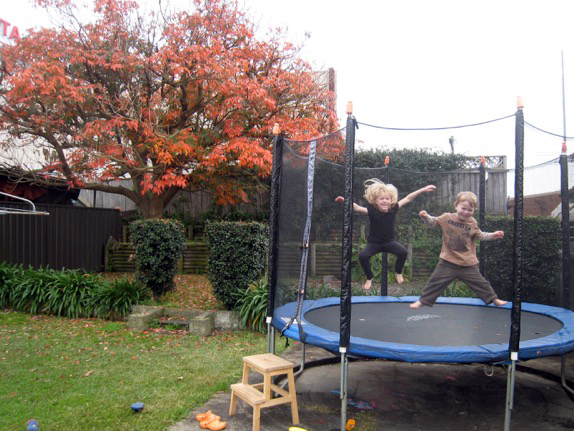If you live in NSW you could have any number of plants in your yard but you wouldn’t think that one of them could cause life threatening allergic reactions. What if such a plant could support your kids’ tree house?
That’s exactly what happened to our family this week when we found out our tree had borers and went to find out what could be done about them. It was only by chance that I stopped to ask what type of tree it was, since we are in a rental property and didn’t know.
We got more than we bargained for when the helpful Flower Power horticulturalist informed me that it sounded like it was a Rhus tree (Toxicodendron succedaneum) and that it is a Noxious Weed.
I had taken pictures of the tree, a leaf sample, as well as branch pieces with borer evidence, but there wasn’t enough specific detail to determine whether it was a Rhus or its look alike, the Chinese pistachio (Pistacia chinensis). The two differences are the type of berry they have as well as the leaf frond. The end of the Rhus frond has a single leaflet instead of a pair of them.
The NSW Department of Primary Industries fact sheet considers Rhus succedanea a highly toxic, allergy-causing tree. It states that the dermatitis is severe, beginning with a rash, redness, itching and blisters wherever skin has contact with the plant or its sap. It can also be accompanied by swelling of the face, arms and legs.
Apparently, Rhus was commonly planted in Australian gardens because of its brilliant Autumn foliage and only became problematic in Sydney in the 1980’s before being declared a Noxious Weed across New South Wales. It has been removed from most areas but is currently still found wild in Sydney and Central Coast regions of NSW.
As such, plants still occur in domestic gardens and can be spread when birds eat the seeds, which can then remain viable for years.
I did more research and found the DermNet description of what can happen with exposure to the Toxicodendron succedaneum. They contain oleoresins (a type of resin) known collectively as rushiol. These compounds can trigger a type IV hypersensitivity reaction, a contact dermatitis, like the one triggered in the United States from Poison Ivy (Toxicodendron radicans) or Poison Oak (Toxicodendron diversilobum).
First co ntact with Rhus does not usually produce a significant reaction. It is the nature of type IV hypersensitivity reactions that subsequent exposure incites a reaction. Reportedly, almost everyone is potentially allergic to Rhus, with continued contact over time resulting in delayed sensitization. But it is not just the sap or the plant that can cause the reaction. Smoke made by burning the plant material can result in symptoms. Highly sensitive people may even have a reaction standing near the tree.
ntact with Rhus does not usually produce a significant reaction. It is the nature of type IV hypersensitivity reactions that subsequent exposure incites a reaction. Reportedly, almost everyone is potentially allergic to Rhus, with continued contact over time resulting in delayed sensitization. But it is not just the sap or the plant that can cause the reaction. Smoke made by burning the plant material can result in symptoms. Highly sensitive people may even have a reaction standing near the tree.
 We have a tree house that my husband unwittingly built in our toxic tree. My kids from the ages of 5, 8 and 11 have been playing regularly in the tree house for three years and haven’t had a reaction. Luckily, they climb a ladder to get on to the platform so don’t actually touch the tree. But we have had limbs starting to die, due to the borer in it, and these have been cut down by my husband: without a reaction so far. Our cat, Pepper, climbs the tree regularly. The kids’ chickens feed from seeds on the ground around the tree and we all eat the eggs from them. Now we’re wondering how much of an impact it has had on us indirectly, especially as we had started to burn the dead branches in our brazier.
We have a tree house that my husband unwittingly built in our toxic tree. My kids from the ages of 5, 8 and 11 have been playing regularly in the tree house for three years and haven’t had a reaction. Luckily, they climb a ladder to get on to the platform so don’t actually touch the tree. But we have had limbs starting to die, due to the borer in it, and these have been cut down by my husband: without a reaction so far. Our cat, Pepper, climbs the tree regularly. The kids’ chickens feed from seeds on the ground around the tree and we all eat the eggs from them. Now we’re wondering how much of an impact it has had on us indirectly, especially as we had started to burn the dead branches in our brazier.
In cases of poisoning, it is advised for serious breathing difficulty or non responsiveness, to call 000 and go to an Emergency Department immediately. If it is not life threatening, then it is recommended to contact the Poisons Information Centre on 13 11 26 for advice or visit your local doctor. Remember to take a piece of the plant, with gloves on, for identification and don’t just take a leaf, take a frond.
Now we are faced with the task of what to do with the tree. It currently stands at its full height of 5 metres and needs to have the cubby house removed. That is the easy part. The branches will need to be removed and the stump has to be injected with herbicide to prevent regrowth. Recommendations for management state that physical removal has high associated risks of poisoning and difficulties of disposing of the plant material. Tools such as chainsaws need to be cleaned to remove sap. Personal protective equipment such as protective eyewear, dust masks and full clothing including gloves should be used.
It is suggested by Primary Industries to wait until winter after the leaves have fallen before attempting to remove plants. There are about two fronds left on our tree so the time has come but who gets the job? That’s where renting in Sydney might actually be beneficial.
By E K Wills
Author of Mum’s the Word: Secret Diary of a First Time Mum
Always with an interest in the environment and natural health, EK retrained in medical school and is now a psychiatry registrar.
After writing her memoir about her experience having her first child, E.K. went on to have another two children, who are the subjects of her sequel and trilogy diaries to come.
Facebook Page: M’s World – Mums and Mental Health



